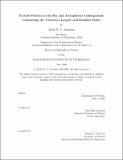Particle physics in the sky and astrophysics underground : connecting the universe's largest and smallest scales
Author(s)
Swanson, Molly E. C. (Molly Ellen Crosby)
DownloadFull printable version (11.10Mb)
Other Contributors
Massachusetts Institute of Technology. Dept. of Physics.
Advisor
Max Erik Tegmark.
Terms of use
Metadata
Show full item recordAbstract
Particles have tremendous potential as astronomical messengers, and conversely, studying the universe as a whole also teaches us about particle physics. This thesis encompasses both of these research directions. Many models predict a diffuse flux of high energy neutrinos from active galactic nuclei and other astrophysical sources. The "Astrophysics Underground" portion of this thesis describes a search for this neutrino flux performed by looking for extremely high energy upward-going muons using the Super-Kamiokande detector, and comparing the observed flux to the expected background. We use our results to to set an upper limit on the diffuse neutrino flux from astrophysical sources. In addition to using particles to do astronomy, we can also use the universe itself as a particle physics lab. Cosmology provides new insights that could never be observed in terrestrial laboratories. The "Particle Physics in the Sky" portion of this thesis focuses on extracting cosmological information from galaxy surveys. To overcome technical challenges faced by the latest galaxy surveys, we produced a comprehensive upgrade to mangle, a software package that processes the angular masks defining the survey area on the sky. We added dramatically faster algorithms and new useful features to this software that are necessary for managing complex masks of the Sloan Digital Sky Survey (SDSS) and will be invaluable for future surveys as well. With this software in hand, we utilized galaxy clustering data from SDSS to investigate the relation between galaxies and dark matter by studying relative bias, i.e., the relation between different types of galaxies. If all galaxies were perfect tracers of dark matter, different subpopulations would trace each other perfectly as well. However, separating galaxies by their luminosities and colors reveals a complicated picture: red galaxies are clustered more strongly than blue galaxies, with both the brightest and the faintest red galaxies showing the strongest clustering. Furthermore, red and blue galaxies tend to occupy different regions of space, effectively introducing an element of stochasticity (randomness) when modeling their relative distributions. In order to make precise measurements from the next generation of galaxy surveys, it will be essential to account for this complexity.
Description
Thesis (Ph. D.)--Massachusetts Institute of Technology, Dept. of Physics, 2008. This electronic version was submitted by the student author. The certified thesis is available in the Institute Archives and Special Collections. Includes bibliographical references (p. 151-169).
Date issued
2008Department
Massachusetts Institute of Technology. Department of PhysicsPublisher
Massachusetts Institute of Technology
Keywords
Physics.